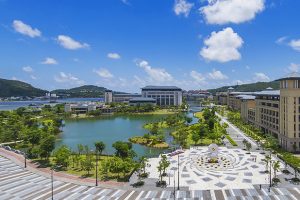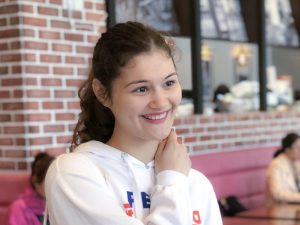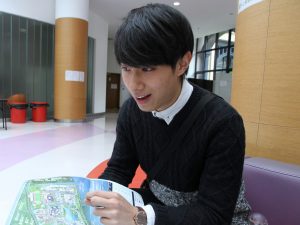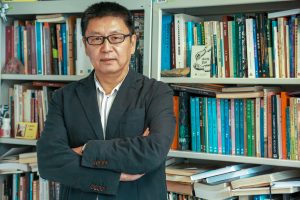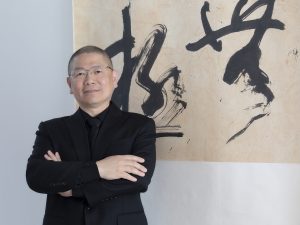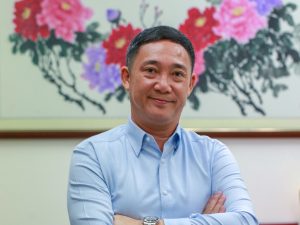Astronomical Telescope
Madalena Branco, a second-year student in the Department of English and a member of Cheng Yu Tung College, hopes that the university will consider installing several astronomical telescopes either on the platform connecting the Humanities and Social Sciences and the Faculty of Business Administration buildings, or on the rooftops of the buildings of different faculties.‘In good weather, you can see the stars at night here. It would be fun to watch the stars with an astronomical telescope,’ she says. ‘If the university will consider installing some telescopes, maybe it can also consider offering some courses in astronomy to make star-watching a fun, educational experience.’
Arts Bridge
There is a famous pedestrian bridge in Paris that crosses the River Seine. It is known as the Arts Bridge. Lovers from around the world visit the bridge and attach love locks to the bridge’s railings. Jimmy Kuok, a fourth-year student from the Department of Management and Marketing and a member of Choi Kai Yau College, once did that with his girlfriend. In his opinion, with a little beautification, the bridge located between the Humanities and Social Sciences Building and the Central Teaching Building has the potential to become a similar ‘lock bridge’.‘I pass this bridge every day, and I always see people from different faculties walking on it,’ he says. ‘I think this area may have the highest pedestrian flow on campus. If we beautify the railings a little bit and encourage everyone to attach a heart-shaped lock or other heart-shaped objects to the railings, I think many students will participate. If the suggestion is adopted, I will be the first to attach a lock.’
The Swan Lake
Prof Yao Jingming, head of the Portuguese department, is a writer and poet with an eye for beauty. Having visited many beautiful campuses around the world, he suggests, ‘The lake on the campus is beautiful, it would be even more beautiful with several pairs of swans.’ The poet seems to have a particular liking for swans. ‘I think it’s important to cultivate beauty in life. Some elegant swans on the green lake would make a beautiful picture,’ he says. ‘We can also erect some artistic sculptures on campus. Last year, we unveiled the “Wall of Great Wisdom” sculpture. Actually we have a lot of empty space on campus, so we can consider erecting more sculptures. Also, we can decorate the walls, both indoors and outdoors, with paintings or works of art, to create an artistic ambience on campus. Being surrounded by beautiful objects can help students and teachers to cultivate a sense of beauty.’ Prof Yao has confidence in students’ creativity and he encourages UM students to propose creative ideas to make the campus more beautiful.
Creating an Environment that Cultivates a Sense of Beauty
Lampo Leong, director of the Centre for Arts and Design and distinguished Professor in the Department of Communication, is a world-renowned artist. He believes environment plays a crucial role in cultivating an artistic taste in the students. ‘ Why is it that Apple and Amazon are willing to spend so much money to construct Apple Park and Amazon Spheres, both representing the highest standard in design, as their office buildings? Because a sense of beauty is cultivated both through professional training and through daily life,’ he says. Prof Leong thinks that as with all the other academic disciplines, it takes strict professional training to appreciate the beauty of arts and design.
New Measures for Beautifying the Campus
Dick Lai, director of the Campus Management and Development Office (CMDO), welcomes suggestions for beautifying the campus. According to Lai, the CMDO is committed to maintaining a safe, beautiful and green campus with distinctive characteristics so that students, faculty and staff can study, work and live here comfortably. Lai stresses that it has been six years since UM’s relocation to the current campus, and some facilities and systems are starting to show signs of wear and tear; so some resources are devoted to the repair and maintenance of these facilities to ensure safe and normal operation of the campus, while other resources are devoted to the construction of new facilities and improvement of existing ones, which include the residential colleges, staff quarter, laboratories, the Guest House, a barbeque area, the greening project on the Central Avenue, and the University Mall. In the process of allocating resources, the CMDO identifies the order of priority based on the benefits a project will confer on the staff and students to make sure that public money is used judiciously.
Lai adds, ‘Macao suffered many violent typhoons in recent years, which wreaked havoc on the campus, uprooting many trees. As a pre-emptive measure against future typhoons, we are adjusting the layout of the green space on campus. For instance, we are adjusting the ratio of trees to shrubs. We are reducing the number of trees while increasing the number of shrubs. For trees, we choose typhoon-resilient species that suit the climate in Macao. For shrubs, we try to create a multi-level and multi-colour effect. In recent years, our colleagues have been experimenting with planting lotus flowers at different locations on the lakeside near the “Wall of Great Wisdom” sculpture, hoping to create a lotus pond to make the campus look more beautiful in summer.’ He discloses the CDMO’s plan to relocate the tortoise pond and the fish pond to the lakeside near the bonsai garden that was unveiled at the end of last year. A small area of water will be delineated from the lake to serve as the new home for the tortoises and fish, which will also make the bonsai garden more interesting.
Lai says last year the university invited a local artist to make a large UM-themed painting, which is now hanging in the lobby of the Guest House. His office is also pushing ahead with the implementation of new greening projects, road improvement works, upgrading of facilities, and improvement of barrier-free facilities on campus in accordance with the new guidelines issued by the Secretariat for Social Affairs and Culture, all in an attempt to create a more beautiful environment in which students, faculty and staff can study, work and live comfortably.
Source: My UM

